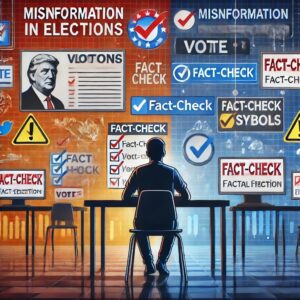Elections are the cornerstone of democracy, a time when citizens decide the direction of their communities and countries. But in recent years, the rise of misinformation has put this vital process at risk, creating confusion, sowing doubt, and even changing how people vote. From wild conspiracy theories to fabricated news stories, misinformation has evolved into a serious threat to electoral integrity, and understanding how to combat it is more urgent than ever.
Misinformation spreads fast, often faster than the truth. In our age of instant communication, a simple tweet or post with misleading content can go viral in minutes, reaching thousands or even millions before the facts catch up. Social media platforms like Facebook, Twitter, and YouTube have become central to this issue, acting as both catalysts and battlegrounds for misinformation during election seasons.
Conspiracy theories, for instance, are designed to stir suspicion and often thrive in echo chambers where people seek information that confirms their beliefs. This type of misinformation plays directly on human psychology: we are more likely to share things that evoke strong emotions, like anger or fear, than dry facts. This dynamic has opened the door to bad actors who deliberately create false content to manipulate voters or disrupt the democratic process.
Misinformation doesn’t just exist in the digital sphere; it has real-life consequences. When voters are misled, their decisions at the polls are impacted, sometimes irreversibly. False information about voting locations or eligibility requirements can discourage people from voting or prevent them from casting a ballot altogether. Additionally, when people lose trust in the fairness of elections due to misinformation, it can undermine confidence in the entire democratic process.
In some cases, misinformation has even led to real-world confrontations, where people act on false beliefs. From protesting election results based on baseless claims to mistrusting election officials, the spread of misinformation is having a profound and potentially long-lasting effect on the way we experience and value democracy.
The fight against misinformation requires a multi-layered approach. Fact-checking initiatives have grown tremendously, with news organizations and independent groups verifying claims and sharing corrected information. But fact-checking alone is often not enough, as corrections rarely spread as quickly as the original misinformation.
Tech companies have stepped up with new tools to flag false content, though finding a balance between open expression and responsible moderation is challenging. For instance, some platforms now add warning labels to potentially misleading content, reducing its spread. However, the rapid pace of technology means that misinformation tactics are always evolving, pushing tech firms to remain vigilant and adaptive.
Educating the public is another vital solution. When people are equipped with critical thinking skills and know how to spot unreliable sources, they’re less likely to fall for misleading content. Schools, governments, and media organizations can work together to promote media literacy, helping citizens navigate information more wisely and make informed voting decisions.
Maintaining electoral integrity in an era of misinformation is a daunting task, but it’s one that must be pursued to protect the foundations of democracy. Each election cycle offers a chance to refine our approaches, whether through improved technology, broader education, or stronger collaboration across sectors. As misinformation continues to evolve, so too must our strategies for combating it, ensuring that when we vote, we are guided by facts, not fabrications.
The stakes are high, but the effort is worth it. When voters can trust that they’re participating in a fair and informed election, democracy becomes stronger, and society benefits as a whole. By working together to push back against misinformation, we can ensure that truth remains at the heart of our democratic process.

